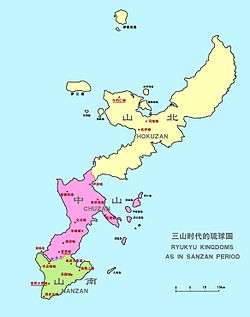Tamagusuku

Tamagusuku (玉城, c. 1296-c. 1336) was a chief[1] of the Ryūkyū Islands.[2]
Tamgusuku was a chief of the Okinawan polity of Chūzan from roughly 1314-1336.[3] He was the third son of Eiji (r. 1309-1313), he was the fourth ruler of the lineage of Eiso (r. 1260-1299).
Succeeding his father Eiji as paramount chief of Okinawa's territorial lords at the age of nineteen, Tamagusuku lacked the charisma and leadership skills to command respect and loyalty from those lords (the anji). A number of these lords rebelled, and the island of Okinawa came to be divided into three kingdoms. Tamagusuku, remaining in Urasoe, became the chief of Chūzan. His failure to institute reforms or innovations in governance is generally claimed as one of the causes of the fall of the lineage (dynasty), which ended with Tamagusuku's son and successor Seii.[3]
The Lord of Ōzato fled south from Tamagusuku's capital at Urasoe and, along with his followers, formed the polity of Nanzan (南山, Southern Mountain).[4]
The Lord of Nakijin, based some distance to the north, declared himself chief of Hokuzan (北山, Northern Mountain).[5] He was succeed by his only son Seii.
See also
Notes
- ↑ Kerr, George. (2000). Okinawa: The History of an Island People, p. 52 , p. 52, at Google Books; although the paramount leaders of Okinawa beginning with Shunten (c. 1166 – c. 1237) are commonly identified as "kings," Kerr observes that "it is misleading to attribute full-fledged 'kingship' to an Okinawan chief in these early centuries... distinctly individual leadership exercised through force of personality or preeminent skill in arms or political shrewdness was only slowly replaced by formal institutions of government — laws and ceremonies — supported and strengthened by a developing respect for the royal office."
- ↑ Nussbaum, Louis-Frédéric. (2002). Japan Encyclopedia, p. 172, p. 172, at Google Books; excerpt, Eisō [with a macron] was "king of the Ryūkyū Islands in the thirteenth century."
- 1 2 Kerr, pp. 59-62., p. 59, at Google Books
- ↑ Kerr, p. 60., p. 60, at Google Books
- ↑ Kerr, p. 61., p. 61, at Google Books
References
- Kerr, George H. (1965). Okinawa, the History of an Island People. Rutland, Vermont: C.E. Tuttle Co. OCLC 39242121
- Nussbaum, Louis-Frédéric. (2002). Japan Encyclopedia. Cambridge: Harvard University Press. ISBN 978-0-674-01753-5; OCLC 48943301
| Preceded by Eiji |
Chief of Ryūkyū Islands 1314 |
Succeeded by — |
| Preceded by — |
Chief of Chūzan 1314–1336 |
Succeeded by Seii |